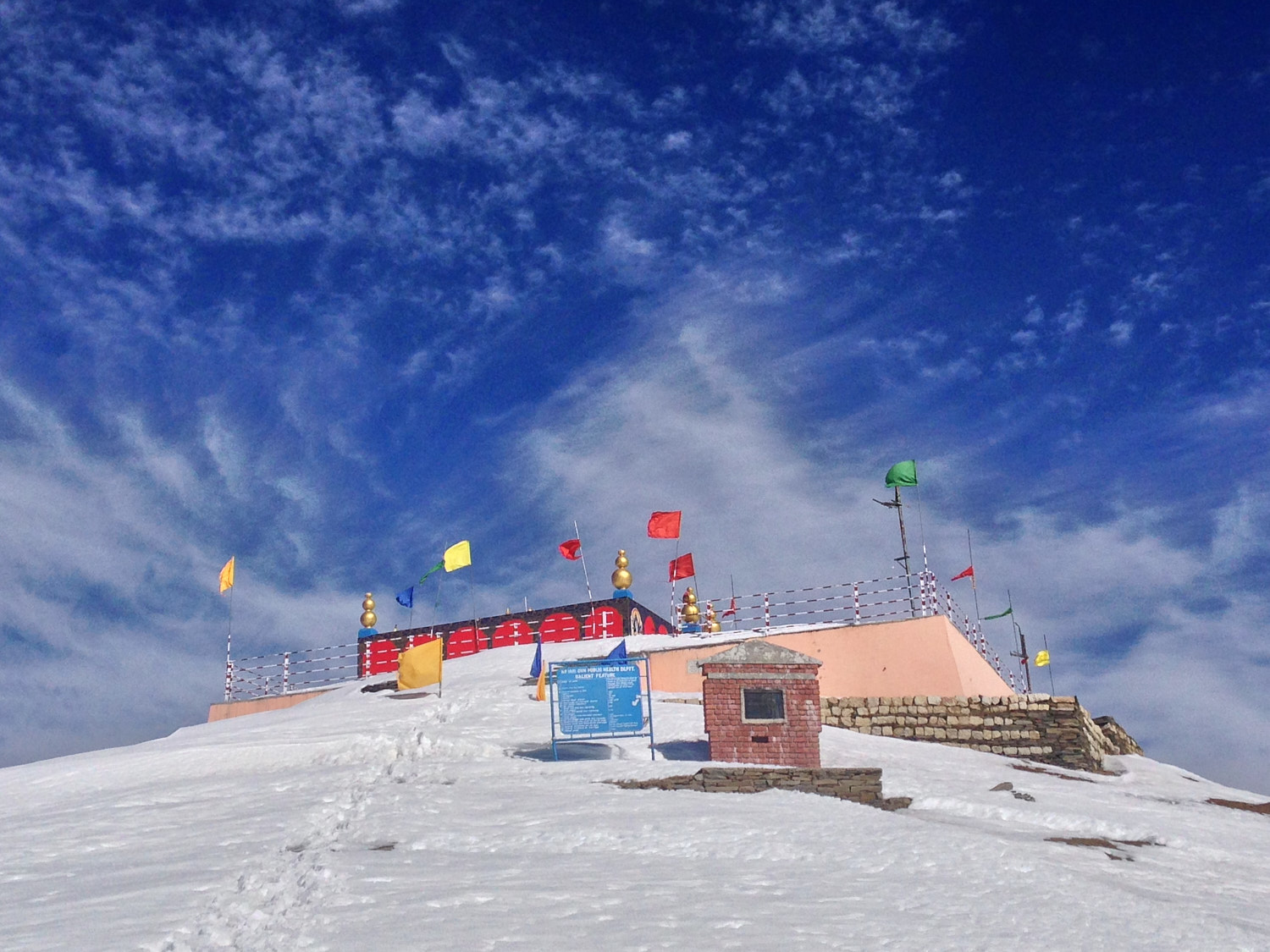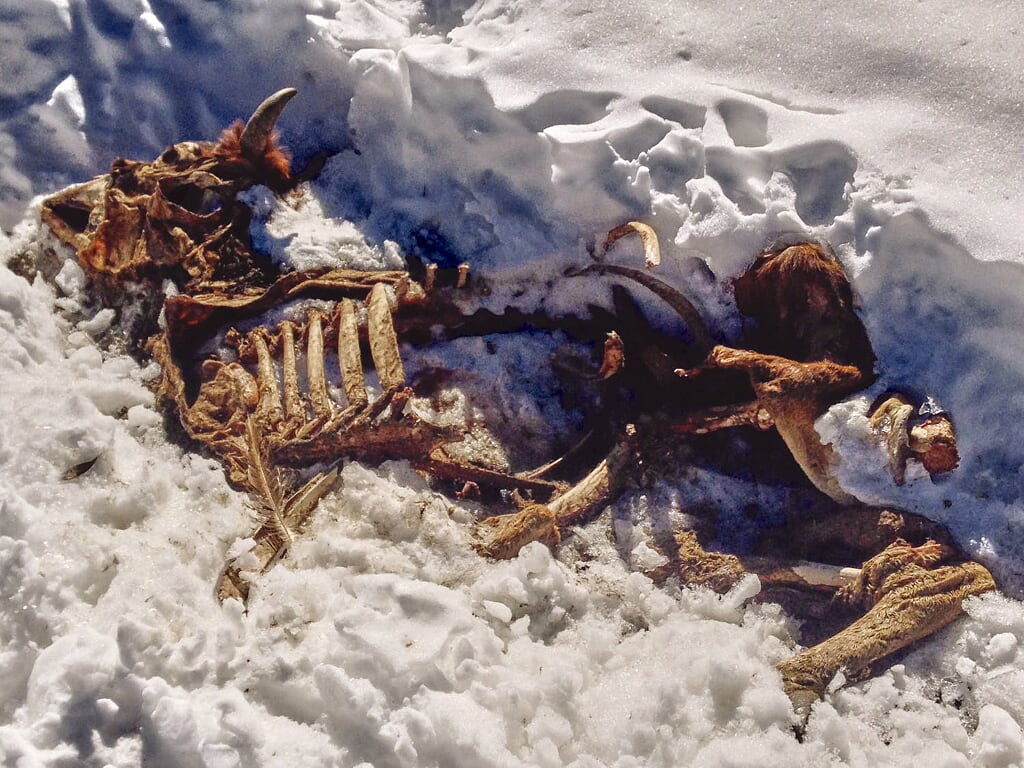Jalsu Pass trek diary part 3

When you wake up to see a goat taking a dump on the floor right next to you, the realisation seeps in that this is not the best place to sleep. Unfortunately, this is the sight I wake up to at Joginder’s shop in Jalsu Gothe.
It is September end and there are numerous Gaddi with their flocks camped at the base of Jalsu Pass. As autumn approaches, the Gaddi are anxious to head back to the relative warmth of Kangra valley. They are making their way back from Lahaul and Bharmour on their annual ‘to and fro’ trek. However, this Gaddi confluence means that goats and sheep have free reign of Joginder’s already not-too-clean tea shop. I remove this shop from my mental ‘recommended teashop’ list.
Eager to be off at first light, I get up and pack my sleeping bear before the sun comes up. Nevertheless, when the sun does come up my thoughts of departure evaporate along with the vanishing darkness. Instead, I spend the an hour photographing the sprawling meadows and the wildflowers near Jalsu Gothe. The sun lights up the sky in pink and orange light. It is called the golden hour for a reason - I mutter as the morning light turns the mountains into a kaleidoscope of colours.
 |
|---|
| A golden sunset at Jalsu Gothe |
Early morning is a busy time at Yada Gothe in September. Gaddi hustle as they prepare to cross Jalsu Pass. Suckling goat kids needs to be fed with an ingenious rubber nipple attached to a cola bottle. A goat with a broken leg needs to be carried across the pass on a Gaddi’s back. Bags need packing, hangovers need nursing and meals need preparation. Through this hustle and bustle, a Gaddi tells me that the last bus to Holi leaves from Laake Wali Mata at 3 PM. It is a 4 to 5-hour walk from Jalsu Gothe to Laake Wali Mata, the road-head and the endpoint for the Jalsu Pass trek.
‘Gothe’ is a generic term for a grazing ground, pasture or a meadow. Also, known as a ‘Bugyal’ in Uttrakhand.
The winding trail from Jalsu Gothe to Bajoda is beautiful. Flanked by lush green meadows dotted with numerous flowers, it is a trekker’s dream come true. Bajoda is a small room (dubbed a Sarai) and a temple about an hour away from Jalsu Gothe. This Sarai at Bajoda is a well-kept secret. I am unable to find a reference to this place in any of my internet research. If I had known about this Sarai, I would have preferred to spend the night here rather than at Joginder’s shop at Jalsu Gothe.
 |
|---|
| Jalsu Gothe to Bajoda trail is beautiful |
I come across two snakes on the trail. One of them was kind enough to scamper off but the other is intent on sunbathing and it needs a few gentle pokes with the trekking pole before it reluctantly relinquishes the trail. I bet you didn’t think of this as a use case when you were packing your trekking poles, did you? I create a mental graph to account for ‘snakes on the trail’.
Snakes->lead to->Shiva->leads to->Mani Mahesh.
 |
|---|
| Approaching Yada Gothe. Yada is an excellent place for an overnight stay and it has the best view of Mani Mahesh/Chamba Kailash and Kuja Peak. |
Yada Gothe is an easy two-hour walk from Jalsu Gothe and an hour from Bajoda. Krishan from Bakluddu had recommended Bhikkhan’s tea shop and I second his recommendation. It is a clean, well-stocked shop and Bhikkhan’s wife makes an excellent chai. Infused with fennel feeds (सौंफ) and ginger (अद्रक) the tea washes away my ennui and adds a definite spring to my step. As I sit gazing at the distant peaks, Bhikkhan recounts the legend of Kuja peak.
Kuja was Shiva’s nephew. Shiva once sent Kuja to look for an appropriate dwelling in the Himalayas. Kuja found an idyllic place near Mani Mahesh and decided to tarry here. After a long time, Shiva came looking for Kuja only to find him tarrying in the Himalayas. In his anger, Shiva raised an arm to strike Kuja. Kuja bent over backwards to avoid being struck down but such was Shiva’s wrath that he was frozen as a stone for all eternity. This is the local explanation for the slant in Kuja Peak.
I leave word with Bhikkhan’s wife and she promises to convey my safe crossing to Krishan’s wife. I rejoin the tree line after Yada Gothe and a series of switchbacks through a wood brings me down to a wooden bridge over a gurgling mountain river. This mountain river is a tributary to Ravi. Two houses that double as shops and a temple along the bridge is Channi campsite. I see some interesting glyphs carved on a stone at the temple, though their meaning remains elusive to me.
 |
|---|
| The bridge leading to Channi campsite |
The trail from Channi to Surai village (3.5 kilometres/one and a half hour) undulates with the mountain face my right and a deep gorge stream to my left. Numerous streams cross the trail on this stretch and some sections need careful crossing. Beautiful rifts of slate, etch vertical lines through the forest across the river. This is a paradise for big wall crag climbers. Numerous untouched routes with varying difficulty.
I cross a bifurcation, where one trail leads to Surai village and the other to Laake Wali Mata. I congratulate myself on a trek well completed. I figure the trek was in the bag and I assume it is a walk-in-the-park to the road head. How wrong was I! The trail laughs. Just after the bifurcation, the trail drops 300 vertical metres to a suspension bridge over the river you’ve crossed before at Channi. It then ascends another 170 vertical meters in a series of zig-zags to Laake Wali Mata. I finally huff and puff through the steep final ascent on to the metalled road at Laake Wali Mata temple. The temple is built on a spur atop a ridge, overlooking the Ravi River valley.
 |
|---|
| Ravi river valley |
A shop next to the temple serves as a one-stop mart for Surai village and it serves a ‘diet meal’ and tea on request. I ask the shop owner about the temple and its legend
The temple is dedicated to a form of Goddess Kali, as assumed by the Goddess to slay the demon who tormented the people of the valley, as Bhramari Mata (Bumble Bee form). There is a ‘Jatar’ (meaning procession) organised by the local Gaddi community during August every year that attracts lots of locals seeking blessings of the reverend Laake Wali Mata. — S Roy Biswas
The HRTC bus arrived on time at 3 PM and I was the only passenger on the bus till Naya Graon (literally - new village). The construction of the controversial Holi-Bajoli hydel power project means that the bus takes its sweet time as it makes its way across heavy tipper trucks on an extremely narrow road. Overnight in Holi at the Public Works Department (PWD) resthouse.
Related
- Part 1 of 3 - [Utrala to Bakluddu]({% post_url 2016-09-24-Utrala-To-Bakluddu-Jalsu-Pass-Trek %}).
- Part 2 of 3 - [Bakluddu to Jalsu Gothe over Jalsu Pass]({% post_url 2016-10-15-Bakluddu-To-Jalsu-Gothe-Over-Jalsu-Pass-Trek %}).




